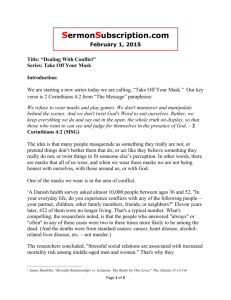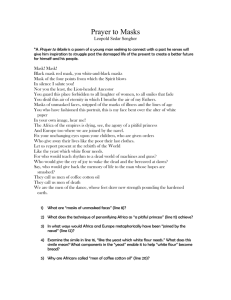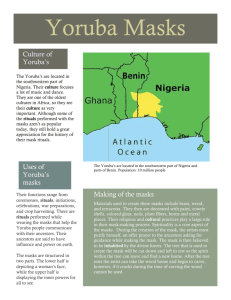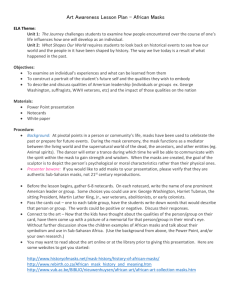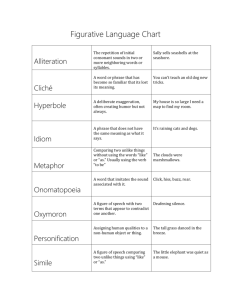Uses of Yoruba's masks
advertisement
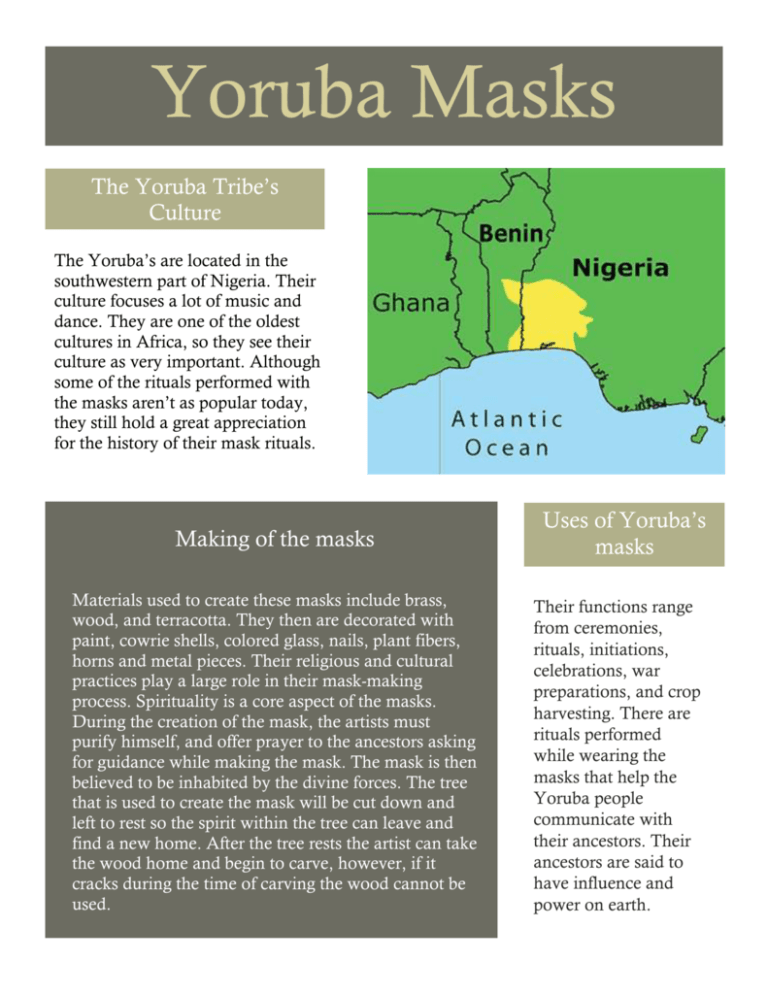
Yoruba Masks The Yoruba Tribe’s Culture The Yoruba’s are located in the southwestern part of Nigeria. Their culture focuses a lot of music and dance. They are one of the oldest cultures in Africa, so they see their culture as very important. Although some of the rituals performed with the masks aren’t as popular today, they still hold a great appreciation for the history of their mask rituals. Making of the masks Materials used to create these masks include brass, wood, and terracotta. They then are decorated with paint, cowrie shells, colored glass, nails, plant fibers, horns and metal pieces. Their religious and cultural practices play a large role in their mask-making process. Spirituality is a core aspect of the masks. During the creation of the mask, the artists must purify himself, and offer prayer to the ancestors asking for guidance while making the mask. The mask is then believed to be inhabited by the divine forces. The tree that is used to create the mask will be cut down and left to rest so the spirit within the tree can leave and find a new home. After the tree rests the artist can take the wood home and begin to carve, however, if it cracks during the time of carving the wood cannot be used. Uses of Yoruba’s masks Their functions range from ceremonies, rituals, initiations, celebrations, war preparations, and crop harvesting. There are rituals performed while wearing the masks that help the Yoruba people communicate with their ancestors. Their ancestors are said to have influence and power on earth. Egungun Masks After reading the section about this mask tradition and observing these masks, answer the following questions with complete sentances Structural Frame How do you think these masks visually reflect the characteristics of male Yoruba ancestors? List two similarities and two differences of these masks: Cultural Frame Egungun is a Yoruba mask making tradition associated with male ancestor lineage. These masks are created in different styles and have a specific name, but do not refer to specific ancestors. The community celebrates the distinguished ancestors with a festival that also serves as a time for renewal in the community. These masks have a function within the culture. Can you think of an example of an art form that represents characteristics of a group in your culture? More Yoruba Masks Gelede Masks Epa Masks The bottom of the mask is representative of ancestors while the more ornate top of the headdress honors deities and cultural heroes such as mothers with children, warriors/hunters, animals and rulers. The Gelede masks are worn by men in intricate masquerade rituals between the months of March and May. This tradition takes place at the beginning of the agricultural season and it is honoring of women’s power. The bottom of this mask is a woman’s face and on the top are snakes and birds. There is not a consensus on the meaning of these masks, but some people have the idea that the birds represent a nurturing mother figure and the snakes represent a figure of power. An alternative meaning behind the snake and the bird, is the idea of struggling forces or a strained relationship caused by an act of injustice in their culture. Some of the people of this culture understand that this is a metaphor for potential crisis or trouble can be alleviated by prudence to their rituals, promoting peace. Thinking about this mask…. Based on what you read about different Yoruba masks, what kind of mask is this? List six adjectives to describe this artwork: Final Summary In your culture or family heritage, what kinds of objects have symbolic meaning? Are these worn? Are they displayed? Using theses adjectives, write a paragraph to describe the artwork to somebody as if they are not looking at it. Vocabulary: Ancestors: A person who serves as an influence or model for another; one from whom mental, artisti c, spiritual, etc., descent is claimed Tradition: The handing down of statements, beliefs, legends, customs, information, etc., from gener ation to generation, especially by word of mouth or by practice Culture: The behaviors and beliefs characteristic of a particular social, ethnic, or age group Ritual: The performance of ceremonial acts prescribed by tradition or by sacerdotal decree. A specific,observable mode of behavior exhibited by all known societies. It is thus possible to view ritual as a way of defining or describing humans. Metaphor: a figure of speech in which a term or phrase is applied to something to which it is not literally applicable in order to suggest a resemblance. References for Further Research: http://www.hamillgallery.com/YORUBA/Yoruba.html http://www.metmuseum.org/ http://www.forafricanart.com/Yoruba_ep_35-1.html

